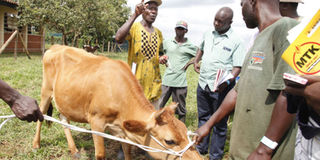Farm Clinic: Dairy production gets a fresh dimension

Farmers listen to a dairy expert (C) during Seeds of Gold Farm Clinic. Photo by Rachel Mabala
The ninth Monitor Seeds of Gold Farm Clinic which took place last Saturday lived to its billing.
The event started few minutes after 8am and in attendance were hundreds of farmers and farming enthusiasts who started to stream at the venue as early as 7am.
Some came from Ibanda, others Bushenyi, Isingiro, Ntungamo, Masaka, Teso, Mbale, Kampala and of course from the larger Mbarara district all eager to interact with experts.
Ready to educate the farmers were officials from NARO and experts from MBAZARDI led by Dr Halid Kirunda.
Lead dairy production facilitator Dr Moses Dhikusooka based his tutorials on the livestock farmers’ forwarded challenges and the session was livened up by Dr Irene Mbatidde’s milk hygiene session that seemed to have touched many participants.
Successful livestock farming
Putting into consideration the day’s main theme – Climate Change - the participants were taught that they need a lot of discipline if they are to get the best out of their farms. Livestock farmers were advised to consider key factors such as how to manage and feed the cow, who will look after them, what kind of pastures they will eat, the breeds they want to own, how long they have to wait before they start to benefit and how much to be invested before it starts being self-sufficient. Dhikusooka, a dairy expert, also availed the donts on dairy production if high yields are to be realized.
“Do not just own animals as a hobby, do not hire relatives without experience to look after the animals and avoid phone or long distance farming,” he warned basically targeting the urban corporates.
He also warned against being comfortable if one milks only one
litre a day, raising many animals on a small plot and not caring about pastures and land use.
Keeping a close look at tick control and good nutrition management, farmers were advised to then plan for farms in a period of five years whilst juggling the zero and open system. The farm in place should have the right pastures sufficient to cater for the cows during wet and dry season.
Participants were argued to also manage the animal numbers in relation to the size of the farm and have a calf management plan as the animals multiply.
Modern breeding
There are various breed improvement methods suggested by the experts at MBAZARDI but the bottom-line remains getting the breeds that feed less and yield more.
To beef farmers, look for breeds that grow faster and gain weight in the shortest period to at least 300 kilogrammes in 18-24 months.
Examples of these breeds can be Brahmam crosses and Boran breeds. For the Ankole or Zebu breeds, since the largest bulk of attendants came from the Western region, they were tipped to leave milk for the calves to suckle to enable them gain weight as fast as they desire. Sticking to local indigenous bulls inevitably leads to slow growth rate characteristics which will affect the scale of production of your enterprise. A farmer who crosses with an improved beef or milk breed recovers his investment faster.
Dhikusooka recommended the use of artificial insemination or investing in good grade bulls from renowned farms to avoid diseases like brucellosis, trichomonas vaginalis and avoid repeat breeding.
Milk market demands
Participants were advised against going for simple and cheap options since they cause unbearable losses to herds.
“Remember farming is a business that should have projections, make profit and be a self-sustaining venture. Fulfilment only comes when you break even in the business and you are able to share your successful experiences with other farmers,” Dhikusooka stressed.
Dairy farmers should have end products of their livestock in their minds and should know the market goal according to the expert.
“Let the demand of this product inspire where to invest on the farm. Don’t invest in a milking parlor when you don’t have milkers.”
Milk hygiene vs. cancer
According to experts, a hygienic milking parlor or an organized milk unit will prevent you from losing your milk during milking time.
Dhikusooka shocked the attentive participants when he revealed they stand getting throat cancer from milk if for example a cow udder that has made contact with pesticide from pastures is poorly handled during milking.
Simply put, the udder must be clean and hands washed before milking. Dr Mbatidde advised participants to have a dust free milking environment, use dry and properly disinfected tools (steel cans), always keep milk covered, take to collection centre immediately after milking and keep it cool at 4-8 degrees.




